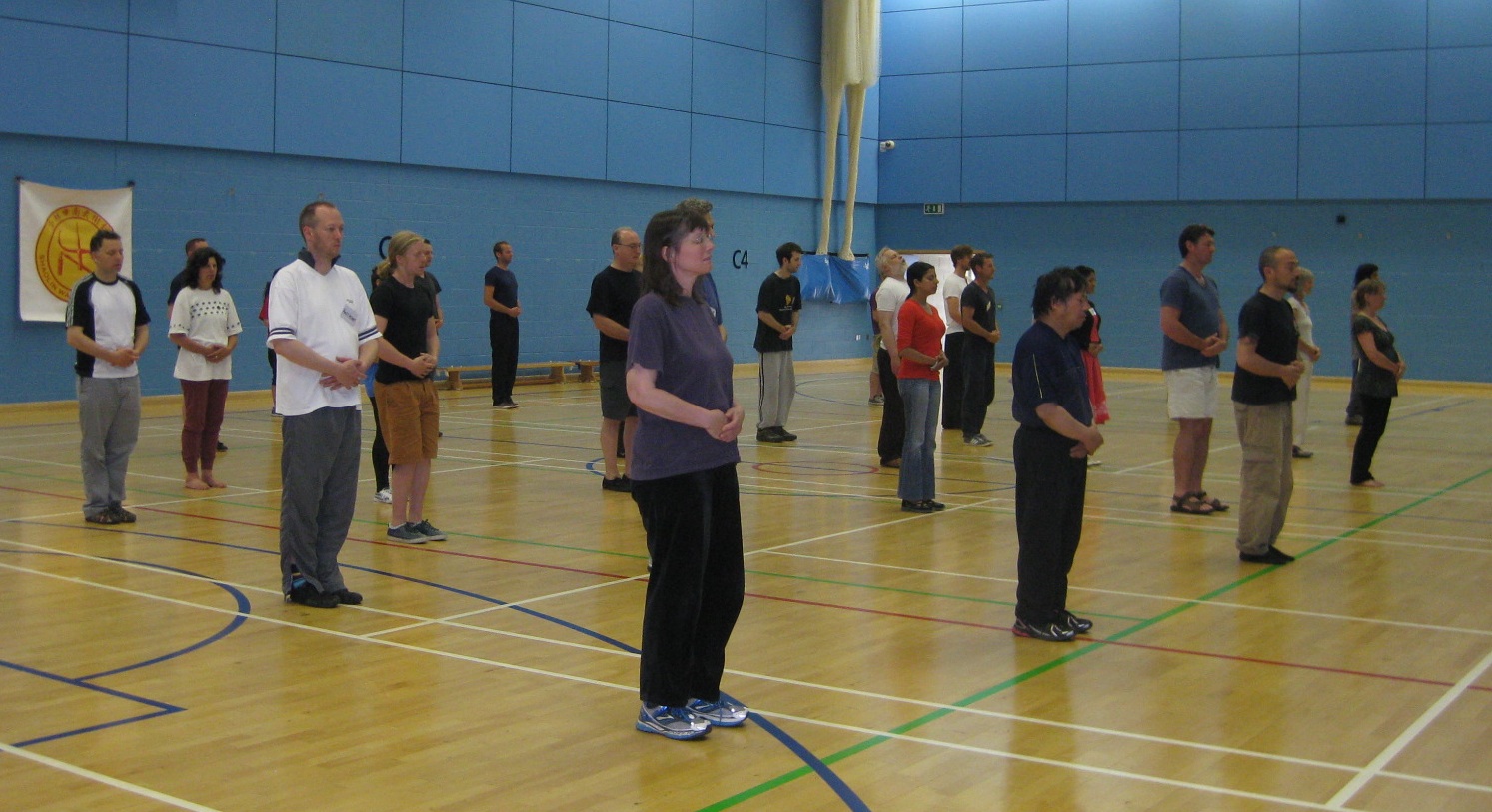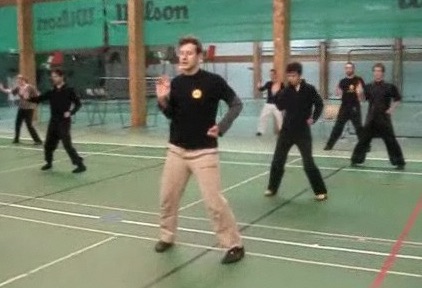COSMIC BREATHING IN CHI KUNG IS GENTLE AND POWERFUL LIKE THE FLOWER SET IN KUNGFU

Cosmic Breathing
Question
In Sifu's Question and Answer Series about the 18 Jewels, Sifu wrote the following:
"Four Gates is like the kungfu counter-part of 18 Jewels, and Triple Stretch the kungfu counter-part of Sinew Metamorphosis".
I don't know if this is a general description of these arts or if Sifu was using these comparisons to make the answers regarding different types of chi flow more clear. In either case, if the comparison was general or meant specifically to highlight the answer about chi flow, or both, what would be the kung fu counter-part of Cosmic Breathing?
Sifu Mark Blohm
Answer
The comparison is a general description of the powerful nature of the arts, and not a specific description of their chi flow.
Many people have a misconception that the more vigorous a chi flow movement is, the more advanced is the art. This is not so, although at the beginners’ stage a more competent practitioner has a more vigorous chi flow movement than a less competent practitioner. But as the two practitioners have progressed to an advanced stage, their external chi flow movement is little, though their internal chi flow, which may not be expressed as external chi flow movement, may be powerful.
In other words, when students start to learn chi kung, they hardly have any external chi flow movement. This is mainly because they are not relaxed and their mind is not clear of all thoughts.
Please note that this situation applies to students in general. Our students are different; as they can enter into a chi kung state of mind readily, they can have a chi flow manifested as outward movement on the very first day of their chi kung training. For most students in general, their first chi flow movement manifested externally may happen only after many months if they are competent. Others who are not competent will not experience any chi flow movement.
We refer to this stage when chi flow movement occurs as the beginners’ stage. For a few students it may happen after a few months; for some it may happen after a few years; and for many it may never happen at all regardless of how long they may have practiced. For these many practitioners who never experience any chi flow, irrespective of whether the chi flow occurs internally or is manifested as external movements, they practice chi kung techniques as gentle physical exercise, and they are unaware of the fact.
If they have been practicing for many years and also are teaching others, they may be regarded as "masters", though in our context they are not even at the beginners’ stage because they have not even started practicing chi kung. They have all the while been practicing gentle physical exercise. But we refer to them as “masters” out of respect.
In our context, we classify whether a practitioner is at a beginners' stage, an intermediate stage, or an advanced stage by his results. If he just starts learning chi kung, or is still in the process of overcoming his pain and illness, we refer to him as at a beginners’ stage. If he has overcome his pain and illness and is able to use the benefits of chi kung to enrich his life, we refer to him as at an intermediate stage. If his chi kung training has enabled him to attain peak performance or he is at a high level of spiritual development, we refer to him as at an advanced stage.
Hence, in our context, time is not a deciding factor. A practitioner may be at an advanced stage after just two years if chi kung training has enabled him to attain peak performance in his daily life or attain a high level of spiritual cultivation.
Most other people classify whether a practitioner is at a beginners’ stage, an intermediate stage, or an advanced stage by the time he has practiced chi kung techniques, often as gentle physical exercise. If the practitioner has practiced for less than a year, he is at a beginner’s stage. If he has practiced for a few years, he is at an intermediate stage. If he has practiced for more than 10 years, he is at an advanced stage.
But some fools, trying to impress others as wise, call themselves beginners even when they have practiced for more than 20 years. Isn't it foolish to remain as a beginner after having practiced an art for more than 20 years? Either they have mastered the art, even at a low level, or at least have become competent practitioners, or they have totally wasted their time practicing chi kung as gentle physical exercise, or kungfu as flowery fists and embroidery kicks.
The comparison between saying Four Gates is the kungfu counter-part of 18 Jewels and Triple Stretch the kungfu counter-part of Sinew Metamorphosis is to show the relative power of Four Gates and 18 Jewels on one hand and Triple Stretch and Sinew Metamorphosis on the other.
Four Gates was the fundamental kungfu set at the southern Shaolin Temple, a set that every kungfu student learned to acquire himself the knowledge and skills in basic combat. Practicing Four Gates was an excellent way for a beginning student to apply basic stances and patterns for fighting. However, when he had progressed to a more advanced level and wanted to develop more powerful internal force and learn more sophisticated techniques, he had to learn more advanced sets like Triple Stretch. The techniques and force training in Four Gates did not fulfil his more advanced needs.
When a person is sick and wants to get well, or if he is healthy and wants to acquire basic chi kung techniques and skills, 18 Jewels is an excellent chi kung set to meet his needs. The exercises in 18 Jewels are simple but sufficient to enable him to enter into a chi kung state of mind and generate an energy flow. These simple chi kung techniques and skills are excellent to fulfil a beginner’s needs in recovering from an illness or benefiting from chi kung benefits of attaining good health. But when he has progressed to a more advanced stage for peak performance or spiritual cultivation, he needs more sophisticated techniques and more powerful force training methods in arts like Sinew Metamorphosis.
The kungfu counter-part of Cosmic Breathing is the Flower Set. Cosmic Breathing and Sinew Metamorphosis are in the same high-level category of chi kung, just as Flower Set and Triple Stretch are in the same high-level category of kungfu. However, Sinew Metamorphosis and Triple Stretch are hard and consolidated, whereas Cosmic Breathing and Flower Set are soft and flowing. All of them are very powerful exercises, and it is a rare privilege to train them, enabling us to excel in perfect yin-yang harmony.
It is worthy to note, if we wish to be more precise, that Cosmic Breathing refers to skills whereas Sinew Metamorphosis refers to techniques. We can use different techniques, like Abdominal Breathing, Reversed Breathing or even performing a kungfu set to activate Cosmic Breathing. On the other hand, we can apply the same Sinew Metamorphosis techniques to activate different skills, like generating an energy flow, developing internal force, or expanding into the Cosmos.
But at the supreme stage, figuratively described as “tang fung choe kaik” in Cantonese or “deng feng zao ji” in Mandarin, which may be translated as “attaining the summit of development and extending the limits of progress” in English, skills and techniques and other terms are convenient descriptions enabling us to obtain better benefits in shorter time, and not as definitives to limit our progress. Though it may sound boastful to our critics, I am happy and proud that many of our advanced practitioners are at this stage. Engaging in sparring for hours and still not out of breath, which is a benefit of Cosmic Breathing, is an indicator.

Flower Set
The above discussion is reproduced from the thread 10 Questions on Cosmic Breathing in the Shaolin Wahnam Discussion Forum.
LINKS
Courses and Classes
